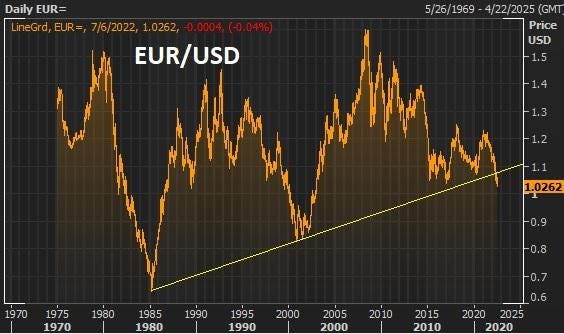EUR/USD Monthly Chart
The Euro has firmly broken below its 20-year trend line. The Euro was created only in 1999. Why this sudden breakdown and what does this tell us?
I think the markets are pricing in any retaliatory measures from Putin against NATO’s efforts to admit Finland and Sweden into the alliance. Remember that Putin has already warned that he would respond in kind if NATO were to deploy military and infrastructure in these bordering countries. Finland has an 830 miles border with Russia which is more than double the current border all NATO countries have with Russia. Sweden doesn’t have any land border with Russia but has a large maritime border. In the case of a major war escalation, Europe will be the most affected and the markets are quick to beat the Euro down.
Markets, in general, have been fairly volatile but we can see a sudden rush into bonds as well. Common sense will tell you in situations like this gold should have gone up but that has not been the case. Most importantly, oil has come down sharply and mortgage rates have come down by half a point. Looks like clearly there has been a safe-haven buying of treasuries on the back of a fear of recession and war.
The market is discounting too many things down at the same time and this has been all orchestrated by the Fed. So it is important to look at what the Fed has done so far. We all know June 1 was the official start of the Fed’s quantitative tightening. Their plan was to extract $1 trillion of liquidity from the financial system over the course of the coming year. They couldn’t have thought of a worse time to start this program than in June. Financial conditions had already tightened. Stocks were already in bear market territory and the mortgage rates had doubled. The fastest rise in history.
So what did the Fed do? Their plan was to sell $30 bln of treasuries but they sold less than $10 bio. They also planned to sell $17.5 bln of mortgage-backed securities but instead, they bought nearly $3 bln.
After watching inflation rise to over 8.6% (as per their records but it is much higher) they have so far raised the Fed funds rate to just over 1.5%. After promising to withdraw $47.5 bln worth of liquidity from the markets, they did only about $7.5 bln.
As in cowboy lingo, the Fed talk so far has been “all hat and no cattle”. As I had highlighted in my past reports, the main job of the Fed is to act less and talk the markets down. So far, they have been successful. They surely have killed the animal spirits of the markets and have created a technical recession with just words.
UBS Chief Economist Paul Donovan believes that it is almost certain that inflation will decline in the second half of 2022 at least in developed economies. His argument is that lockdowns are completely behind us, and there are no signs of the second round of rising inflation, as the wage/cost spiral is absent. According to Donovan, it is certain that inflation will fall, but what remains less certain is how low it will fall.
The tailwinds of low monetary policies are still there and not much has happened on the QT side. Even though the economy is labeled to be in a technical recession with two negative quarters of real GDP, nominal GDP is riding north of 6%.
If you received value from this post, and you’d like to send some back, or if you’d like to signal to me to continue spending time on these types of explorations, feel free to buy me coffees (thank you!):
So, there we go. Thanks for reading Breezy Briefings. If you enjoyed this, I'd really appreciate it if you could take a second and tell a friend. Honestly. It makes such a big difference.
Forward this email. Recommend the newsletter. Share on Twitter, WhatsApp, Telegram, LinkedIn, Slack, wherever!
Join Breezy Briefings’ Official Telegram Channel: https://t.me/BreezyBriefings
Abraham George is a seasoned investment manager with more than 40 years of experience in trading & investment and multi-billion dollar portfolio management spanning diverse environments like banks (HSBC, ADCB), sovereign wealth fund (ADIA), a royal family office and a hedge fund.



